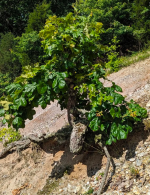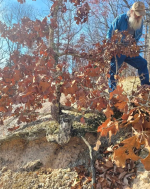goldenginkgo
Seed
- Messages
- 2
- Reaction score
- 4
Hello All,
In winter of 2023 I discovered this post oak growing on a steep incline at an old family farm. For context, the substrate is called chert and the family used to sell it by the dump truck load to the city to use for road bedding back in the 70s. The picture of the dormant tree was taken in December 2023. I pruned it back and it has since shot back many healthy new shoots (as seen in the other photo taken this past summer). I am planning on collecting it in February 2025 and was wondering if anybody had any advice on additional prep work I could do. I'm considering taking a root slayer shovel to the tree to encourage fibrous root growth closer to the trunk and doing light dosing of 0-10-10 fertilizer throughout the winter. I welcome any and all feedback. I'm trying to collect it in February because I'm not sure if the farm will be sold in the near future.
In winter of 2023 I discovered this post oak growing on a steep incline at an old family farm. For context, the substrate is called chert and the family used to sell it by the dump truck load to the city to use for road bedding back in the 70s. The picture of the dormant tree was taken in December 2023. I pruned it back and it has since shot back many healthy new shoots (as seen in the other photo taken this past summer). I am planning on collecting it in February 2025 and was wondering if anybody had any advice on additional prep work I could do. I'm considering taking a root slayer shovel to the tree to encourage fibrous root growth closer to the trunk and doing light dosing of 0-10-10 fertilizer throughout the winter. I welcome any and all feedback. I'm trying to collect it in February because I'm not sure if the farm will be sold in the near future.



